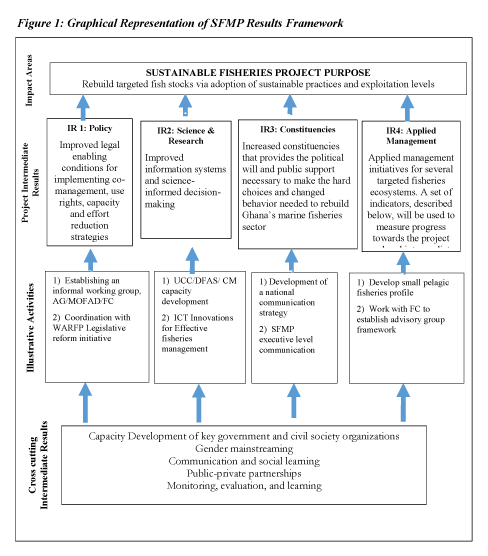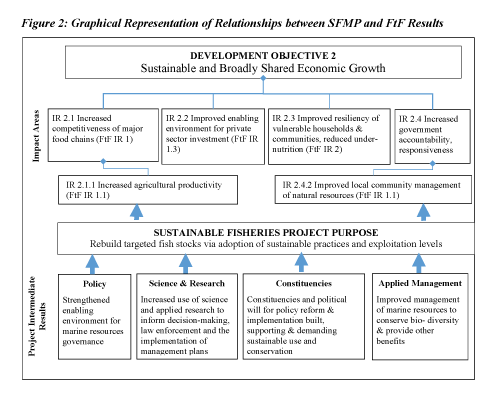Results Framework - SFMP
Sustainable Fisheries and Management Project Results Framework
The Results Framework is shown in Figure 1. It incorporates several changes from the RFA results framework, as noted in the theory of change section below. This includes a more positively reworded project purpose or goal of; Rebuilding targeted fish stocks, through adoption of sustainable practices and exploitation levels. Adoption of sustainable fishing practices and reduced exploitation levels that end overfishing is the only way Ghana can increase its wild-caught local marine food fish supply and bring greater profitability to the fishery, with the potential to benefit over 130,000 people directly and up to two million indirectly as well as recoup tens of thousands of metric tons of food fish supply annually lost due to poor governance.
The SFMP’s integrated results framework include four project intermediate result areas to achieve the ambitious project goal:
- IR 1: Improved legal enabling conditions for implementing co-management, use rights, capacity and effort reduction strategies;
- IR 2: Improved information systems and science-informed decision-making, and
- IR 3 Increased constituencies that provides the political will and public support necessary to make the hard choices and changed behavior needed to rebuild Ghana’s marine fisheries sector. These components feed into
- IR 4: Applied management initiatives for several targeted fisheries ecosystems. A set of indicators, described below, will be used to measure progress towards the project goal and intermediate results.
The project is based on the assumption that, given the open access nature of the current fishery, sustaining short terms gains from reduced fishing effort beyond the SFMP requires that a larger suite of interventions and outcomes be implemented. To this effect the applied management initiatives will include activities that aim to improve fisheries value chains, improve biodiversity conservation, and improve household resilience.
The results framework includes several important cross-cutting themes including capacity development of key government and civil society organizations, social learning, gender mainstreaming and Public-Private-Partnerships. The PMP has mainstreamed indicators that capture progress towards these cross-cutting themes.

Relationship of the Project Results Framework to USAID Ghana Development Objectives and FtF Results
The results framework and associated indicators conform and contribute to USAID/Ghana’s larger Country Development and Cooperation Strategy (CDCS) and its second Development Objective: sustainable and broadly shared economic growth and the Feed the Future (FtF) results framework. This is depicted in Figure 2 below. The Project will support all four integrated Intermediate results (IRs) under DO2, with a focus on IR 2.1 and 2.4.
- 2.1: Increased competitiveness of major food chains (FTF IR 1)
- 2.2: Improved enabling environment for private sector investment (FTF IR 1.3)
- 2.3: Improved resiliency of vulnerable households and communities and reduced under-nutrition (FTF IR 2)
- 2.4: Increased government accountability and responsiveness (FtF IR 1.1)
The Ghana FtF strategy recognizes that marine capture fisheries are the major economic activity along the coast and their importance reaches far beyond the coast. Because fish make up 22.4 percent of food expenditures of all households and is the most important source of animal protein in Ghana, the FtF strategy explicitly includes fisheries. The FtF program states that it will support “direct, targeted interventions where the poor fisheries dependent households are located and focus on what has greatest potential for improving their situation, as well as the environment. The program will increase the ability of coastal residents to better access and manage their most important productive asset–marine fisheries. Interventions will ensure that both men and women engaged in aquaculture and fisheries are able to control management of and decision-making over this asset.”
The SFMP project is designed to support the Feed the Future Strategy and the project’s IRs are directly linked to the Ghana Feed the Future Strategy. Implementing activities to improve fisheries governance and value chains will support IR 2.1.1 on increased agricultural productivity (FtF IR 1.1) by reducing fish landing spoilage and in the long run increasing catches. Due to the explicit focus on fisheries, we assume that fisheries productivity is covered under these IRs even though the indicator is stated as “agricultural productivity”. Fish in this case is assumed to be an agricultural commodity.
The project contributes to IR 2.4.2 (FtF IR 1.1) on improved local community management of natural resources through the work on developing a more conducive legal environment for co-management and use rights, through the development of technical working groups and advisory groups, and the extensive stakeholder consultation process for development of management plans for targeted fish stocks at three ecosystem scales.
The project also contributes to a lesser extent to IR 2.2 and 2.3. Under IR 2.2 (FtF IR1.3), the project aims to improve the enabling conditions for private sector investments through its work with SSG advisors by designing several strategic private sector partnerships.
Under IR 2.3 the project will improve resiliency of vulnerable households and communities via the work on prevention of child labor and trafficking in the Central Region and through activities that strengthen RCC and district abilities to develop coastal community resilience plans that are mainstreamed into district spatial plans and medium term development plans.

